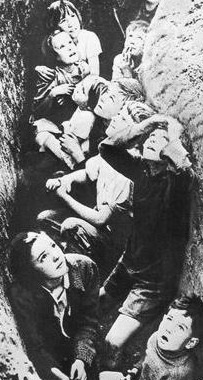
As war loomed a variety of shelters were devised to protect people from possible bombing raids carried out by the Luftwaffe. They ranged from Trench shelters to the indoor Morrison shelter. The following focuses on the various types of shelters available and how people coped with the sometimes difficult conditions they presented.
Hitler was unable to launch an invasion on Britain so turned to bombing in the hope that it would cripple the economy and the will of the British people.
To protect civilians from this kind of terror bombing Sir John Anderson devised a plan as early as 1938 that some kind of shelter should be produced. Sir John was given responsibility for Air Raid Precaution and the Anderson Shelter was born. It was so popular that by September 1940 2,300,000 had been distributed. The shelters were free to those that earned less than £250 a year with a charge of £7 made to those that were on a higher income.
The shelters themselves could accommodate up to 6 people and was usually erected in the backyard of any home. They were made up of curved corrugated steel sheets. First, a shallow pit had to be dug in the ground of the backyard, this usually measured about ten feet by four feet. Then you erected the six sides bolting them together, the curved ends formed the roof of the shelter. Then the rear section was put into place followed by the front in similar fashion except that provision was made for an entrance. The shelters were then usually covered in a thick layer of earth (15" was recommended).
The Anderson Shelter could withstand anything but a direct hit. Families made the best of their shelters and usually kept books, non perishable foods and toilet facilities in the shelter. Although advised against it for health reasons, toilets usually meant a bucket in the corner just in case!
It is interesting to note that the Anderson Shelter was originally named after its designer Dr David A Anderson and not the Home Secretary Sir John Anderson. Although in principle a good idea, this type of shelter only applied to some 27% of the total population as many people did not have their own gardens in which to erect an Anderson Shelter.

PICTURE ABOVE: A lucky escape! Two civilians emerge unscathed from a battered Anderson shelter.

PICTURE ABOVE: Residents receiving their Anderson shelters in early 1940.

NEWSPAPER CUTTING: A headline from the Daily Express in May 1940 stressing that shelters should be assembled.
Another type of shelter issued was the Morrison shelter. Introduced in 1941, it was named after Herbert Morrison, Minister of Home Security. A family shelter, free for most people, it could be erected indoors. It had a steel plate on top, which could be used as a table in the day time, and sides of wire mesh 2ft, 9in high. Over half million had been distributed by 1941.
A comic view of the Morrison Shelter can be viewed here.

CARTOON CAPTION: "By the way, did you remember to feed the canary?"


People found the Anderson shelters cramped and uncomfortable with flooding a common problem. It is true to say that people often spent more time bailing them out than sheltering in them. Communal surface shelters were also considered uncomfortable because they were often badly ventilated, cold, dark and damp. They were also unsafe because they were often constructed in a hurry and due to shortages of cement. A force of a bomb nearby could see them collapse and people were too frightened to use them. As for the Trench shelters they were impossible to keep waterproof because lining materials were in short supply. Londoners turned to other cover and this usually meant taking cover in deeper shelters such as the underground stations. People felt safe in these types of shelters although many casualties were caused as a result of direct hits on some of these stations.
It is also true to say that a lot of people decided to stay indoors during a raid, often hiding in a cupboard or under a table, preferring to stay close to each other and with their children. Nevertheless the Anderson and Morrison shelters did play their part in saving many lives and are looked back with thankful and fond memories.
Click on the image to hear a World War Two Air Raid Siren - time to take cover!
Click on the image again to stop the World War Two Air Raid Siren – all clear!

PICTURE ABOVE: The erection of a brick street shelter. Until later modified they were usually dark, dirty and dangerous places to take shelter.

CARTOON ABOVE: A comic view of how some people tried to make life as comfortable as possible in the underground stations.
(Caption reads: - "What did I tell you? Give them an inch and they take a mile!")